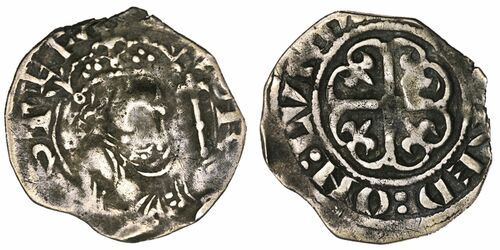
Auction: 23006 - The Official COINEX Auction at Spink
Lot: 98
Stephen 'of Blois' (1135-1154), "Transitional Coronation Issue", Penny, struck with an obverse die altered from the substantive Type XV of Henry I, 'Watford' Type, struck December 1136, "London", "Leofræd", "under the direction of the Abbot of Reading (Hugh of Amiens)", + STEFANVS REX [over HENRIC], crowned bust right, with "annulets in crown", sceptre before, rev. [LIEF]RED : ON : LVND : cross moline with a fleur in each angle, 1.32g [20.37grns], 10h (E Rashleigh [1909], 530* [Watford 1818 Hoard] same dies ["previous to the discovery of this hoard, this particular reading of Stephen’s name was unknown upon his coins; only three examples were in the find"]; W J Andrew [BNJ, 1921], p. 310; B H I H Stewart, "Stefanus R", NumChron [1972], pp. 167-175 this coin cited and Pl. 16, no. 13 this coin; SCBI 20 [Mack], 1605 same dies; SCBI 48 [Northern Museums], 1242 [Prestwich Hoard], same dies; cf. North 875/1; cf. BMC I; cf. Spink 1278), the portrait a little soft with a dent by eye, struck on a typically irregular flan, scarcely fine / good fine, an excessively rare 'altered die' Penny, with the equally unusual 'STEFANVS' legend, speculated by Andrew to have been struck under the instruction of the Abbot of Reading for the Coronation of King Stephen on Boxing Day 1136, an extraordinary transitional type of which only 'a half-dozen extant' were known to Stewartby in his critical reappraisal of this unusual coin for his 1972 Numismatic Chronicle article 'Stefanus R' from this coin in which he opined that it was actually struck towards the end of the Watford Type coinage, c. 1141
Provenance
Lord Stewartby, Part I, Spink 234, 22 March 2016, lot 358 - £1,000
~ "Stefanus R", NumChron, 1972, p. 169 (d) and Pl. 16, no. 13 this coin ~
A H Baldwin, by private treaty [with this envelope], by 1972
"without known pedigree"
But subsequently, presumed to be:
F A Walters, Sotheby's, 1932, lot 126 [part] - "...(a) three annulets on the crown and the legend appears to have been erased in the die..."
~ At the 26 October 1921 Meeting of the British Numismatic Society, Mr F A Walters (President), invited exhibits for the reading of W J Andrew's paper, including:..."By the President, Stephen, the Penny from the late Lord Peckover's collection, reading + LIEFRED ON LVND, of the type attributed to the Abbot of Reading in the paper. It was found in the river Witham. ~
Lord Peckover, Sotheby's, 12 July 1920, lot 243 [part] - "...Stephen, Pennies (2), type i, WILLEM on LV; and another, well preserved...." - £2.16.0 [Baldwin]
~ Reportedly found in River Witham (Lincolnshire), before 1875 ~
W J Andrew, writing in the BNJ (Vol. 16, 1921-1922, pp. 311-313), "A Numismatic History of the Reign of Stephen", noted: "Mr. Andrew first exhibited drawings of two coins of the Empress Matilda which had hitherto escaped attention. One was of a penny found by General Pitt-Rivers 'inside the citadel' during his excavations at Caesar's Camp, Folkestone, in 1878, but assumed to be an ordinary coin of Stephen, It was, however, from the same dies as the very clear example of the Oxford mint exhibited and described by Mr. Wheeler. Unfortunately, the coin seemed to be now lost. The other drawing he had made in 1898 of a well-preserved coin of the Bristol mint in the Bodleian Collection, reading: MATILDI [IMP:]; reverse, [+ TVRC]bIL DE : BRIS.
Turning to the events that immediately followed Stephen's snatched Coronation on December 26, 1135, "he instanced the five curious coins, reading + STEFANVS R, with reverses + SMEPINE : ON : LVND and + LIEFRED : ON : LVND:. They were from the same obverse die, which was as nearly true to Stephen's first type as could be attained by altering a die of the last coinage of Henry I. They bore the elaborately arched crown of Henry's money; and the Smewine coin, exhibited by Mr. Wheeler, being very clearly struck, showed signs of actual alteration in both legend and design. This fact, coupled with the ecclesiastical annulets upon them, suggested a hurried issue by the two London moneyers, working in relays with one obverse die, to meet the great demand for money at Reading Abbey, where the nobility of England were to meet on February 6 for the state funeral of King Henry I. The Abbot of Reading had under his charter a right to one moneyer only in London, but it would be part of Stephen's propaganda that money bearing his name and title-so doubtful as the latter was-should be spread broadcast through the land, and especially to the great gathering at Reading."
Subject to 20% VAT on Buyer’s Premium. For more information please view Terms and Conditions for Buyers.
Sold for
£1,600
Starting price
£1000




